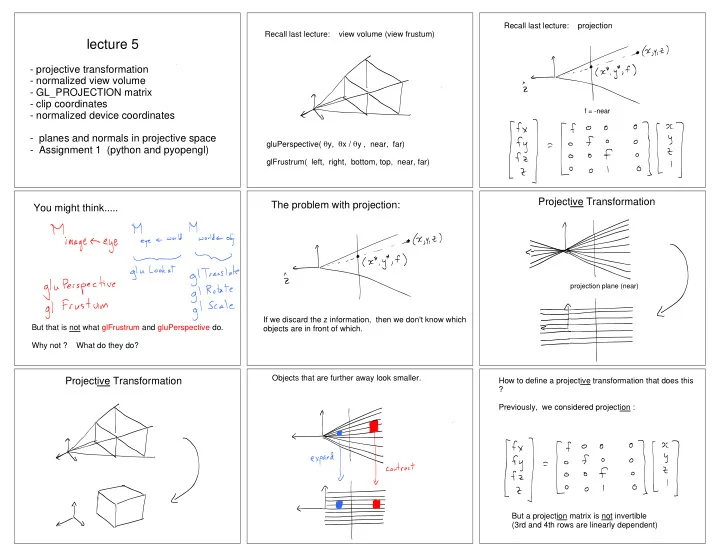

Recall last lecture: projection Recall last lecture: view volume (view frustum) lecture 5 - projective transformation - normalized view volume - GL_PROJECTION matrix - clip coordinates f = -near - normalized device coordinates - planes and normals in projective space gluPerspective( y, x / y , near, far) - Assignment 1 (python and pyopengl) glFrustrum( left, right, bottom, top, near, far) Projective Transformation The problem with projection: You might think..... projection plane (near) If we discard the z information, then we don't know which But that is not what glFrustrum and gluPerspective do. objects are in front of which. Why not ? What do they do? Objects that are further away look smaller. Projective Transformation How to define a projective transformation that does this ? Previously, we considered projection : But a projection matrix is not invertible (3rd and 4th rows are linearly dependent)
Projective Transformation In Appendix to lecture notes, I derive (easy) : We choose and to satisfy desired map illustrated on previous slide. z = -near z = - far where where Where do various regions map to ?
Curious ! The JKL flipping is analogous to a Why is the above detail important ? Mobius strip. We decide whether or not points lie in the view volume using projective space representation. To make these decisions correctly, we need to be careful about inequalities and signs. More about this later... Another (surprisingly) important detail: ? See next slide OpenGL uses the 2nd matrix above, not the first. "Normalized view volume" Why ? Soon we will see why this is desirable. Putting in all together ... Map to normalized view volume (w x, w y, w z, w) 1) translate (left, bottom, -near) to (0,0,0) is in the 2.) rescale x, y, z so volume is 2 x 2 x 2 and flip z axis (into left handed coordinates !) normalized view volume if : 3.) translate so volume is centered at origin w > 0 (Recall a few slides ago) - w <= w x <= w - w <= w y <= w - w <= w z <= w
Object "Clip "Clip Coordinates" "Normalized Object Coordinates Coordinates Coordinates" Device Coordinates" "Perspective Division" In OpenGL, this happens after clipping (next lecture) The surface normal of a plane (triangle) does not necessarily get mapped to the surface normal of the mapped plane (triangle). Why not ? (Space is deformed, and so right angles are not preserved.)
Announcements Today is ADD/DROP deadline http://www.mcgill.ca/importantdates/key-dates For the Assignments, we will use PyOpenGL (Python). It is already installed on the lab computers. Fahim (T.A.) has posted instructions for you to install it on your computer: except in http://cim.mcgill.ca/~fmannan/comp557/Python%20and% special 20PyOpenGL%20Installation.html situations If you need help with the installation, see him (or help each other -- please use the discussion board). We will try to get the assignment out Thursday as originally planned.
Recommend
More recommend